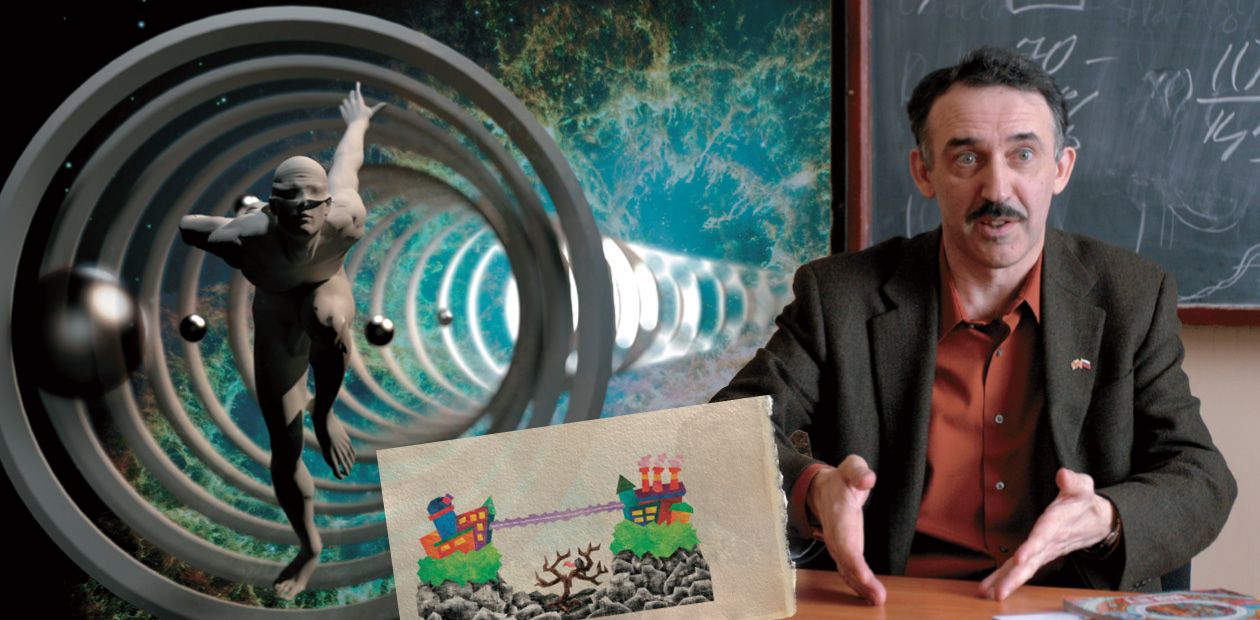The Epoch of Acceleration
Before becoming the director of a research institute in the United Kingdom, Andrei Seryi, a former graduate of the Physics Department of Novosibirsk State University (NSU), had gone a long way. First, he worked at the Institute of Nuclear Physics (INP) SB RAS in Novosibirsk Akademgorodok, then at the INP branch in Protvino (Moscow Region). Before receiving an invitation to work at the Stanford Linear Accelerator Center (California, United States) in 1999, Seryi worked at the Center for Nuclear Energy near Paris and at the Enrico Fermi National Accelerator Laboratory (Fermilab) near Chicago. In 2008, he was elected a member of the American Physical Society for his contribution to the development of the linear collider, and two years later he headed the Institute for Accelerator Science named after the famous British physicist John Adams, who was one of the Directors General of CERN. Andrei Seryi does not forget his historical and scientific “roots” and shows a good sense of humor in the way he cares about the future of science. Together with his wife, a graduate of the NSU Natural Sciences Department, he established a scholarship for successful students of NSU, but only for married couples from two departments: the Physics Department and the Natural Sciences Department
One of the most spectacular phenomena that we can observe with the naked eye is a meteor shower, a wide glowing trail left by tiny grains of matter. Even more amazing are auroras borealis, an outcome of collisions of solar accelerated subatomic elementary particles with the atmosphere. Cosmic rays—elementary particles of tiny masses, which enter the Earth’s atmosphere with an energy of a cricket ball—are much more difficult to observe, and their acceleration mechanism remains a mystery. Today, we know how to accelerate elementary particles under the terrestrial conditions by using manmade accelerators. This invention has opened prospects for the development of new technologies and expanded possibilities to explore the Universe.
Today, the elementary particle energies achieved in accelerators are less than a millionth of those of the most energetic space particles, but physicists and engineers will soon go head-to-head with nature: they have designed methods for simultaneous acceleration of billions and billions of particles and found out how to focus a particle flux and compress it to a tiny size. For instance, one of the most ambitious modern accelerators—the Large Hadron Collider (LHC) at CERN—accelerates proton beams to an energy equivalent to that of Boeing 747 at takeoff, and this energy is concentrated in a “point” less than a human hair in diameter.
Annually, tens of millions of people make use of the diagnostics and treatment based on particle accelerators, and all the products that are processed, treated or inspected by particle beams have a collective annual value of more than $500 billion (Accelerators for America’s Future, DOE, 2009). Accelerator technology was used in one third of all the research works awarded with the Nobel Prize in physics (Chao et al., 2010)The fact that following the example of the great Renaissance, the Epoch of Revival, we are now willing to devote so much effort to investigate the most fundamental bases of nature and to invest heavily in accelerators and other machines enabling this research is a sign of civilized society. Of course, there are many practical issues that call for the attention of accelerator scientists. However, in this case, theory and practice go hand in hand: the support for basic research enables the development of systems and technologies for widespread use and encourages the training of specialists able to conduct future-oriented research.
In the United Kingdom, the centers that are engaged in this research include the John Adams Institute for Accelerator Science (JAI) and its counterpart in the northwest of England—the Cockcroft Institute of Accelerator Science and Technology (CI), both established in 2004. The two institutes are unique organizations as they were established on the basis of several universities. For instance, the JAI was originally organized by the University of Oxford and the Royal Holloway University of London, and since 2011, thanks to the efforts of the current director of the JAI, the London Imperial College has also become a partner of the JAI.
“Our institute has 25 professors, and the rest are postdocs and postgraduate students. All together (about 80 people), we form a big 'accelerating' team; administrators, engineers and other technical professionals are provided by the Oxford University, Imperial College and Royal Holloway. The universities also take care about patenting, publications, grants, etc.; thus, researchers themselves are free from routine work to support their studies. However, such an academically free environment does not mean that we do whatever we like: we need to follow the advice of independent experts.“Every few years, there is a regular meeting of a commission of invited experts to whom we report on what we have done and what we are planning to do. There are different criteria for evaluating the work of scientists, not only the number of publications. By the way, there can never be many publications in accelerator physics. We even have a joke: ‘We publish in iron and concrete.’ Our facilities are our publications. And the commissions who evaluate our work understand that.
“As concerns the financing of the institute, about one third is the professors’ salaries; this is a stable part. Another third is the core financing from the UK analogue of the Russian Ministry of Education and Science; to extend this financing, we are required to provide, once in a few years, a report and plans for the future. The last third of the financing comes from grants, projects, contracts, cooperation with companies, etc. This is the money we have to fight for almost every day by struggling with the intense competition, which is natural for modern science.”
The JAI works in close cooperation with well-known British and international research organizations, including CERN, the Rutherford Laboratory, and Diamond Light Source*, and with industrial companies. The JAI develops new accelerators for basic research together with systems that have biomedical and industrial applications. The JAI also has an international reputation for training the next generation of accelerator physicists to work at national research laboratories and in the industry.
“Cross-fertilization”
It is not always possible to predict which of the innovative results obtained during the development of new particle accelerators for elementary particle physics will have practical applications in other fields of science, medicine, or engineering.
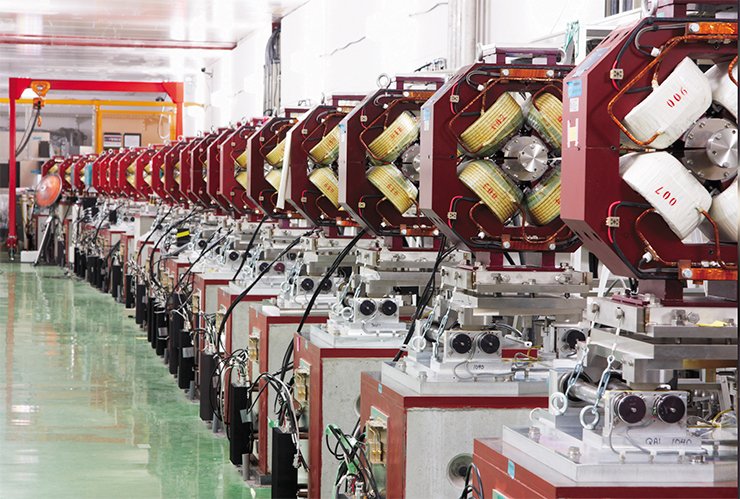
For instance, who could have foreseen that the attempts to establish information communication within such a global research project as CERN would lead to the creation of World Wide Web, which has now literally taken over the whole world? Another example is advanced detectors of elementary particles, which have served as a basis for designing the best mass spectrometers for chemical and biological research.
An example of a scientific and technological problem of today is the creation, accumulation, and focusing of beams of such short-living elementary particles as muons. These particles are inherently unstable; however, in the future, they can be used to design relatively compact accelerators of the next generation. In addition, the methods for focusing muon beams, which are now intensively studied at the JAI, can also have, as it turns out, interesting medical applications.
Thus, the ideas generated during the development of the muon collider inspired researchers to develop a new design for an anticancer therapy device. Nowadays, the most common device for treating cancer is electron accelerators, which generate X-rays aimed at destroying tumor cells. The more up-to-date therapies use protons or even light ions instead of electrons, and this approach permits more accurate “targeting” of tumors and minimizes the irradiation of the surrounding healthy tissue and the ensuing damage to sensitive organs. The methods currently developed at the JAI enable more accurate targeting of the ion beams to ensure a more effective impact.
There are numerous cases illustrating the degree of “cross-fertilization” between the research conducted at the JAI and in the industry. In particular, the study of coherent radiation of electron beams stimulated the development of compact terahertz sources with potential applications in information technology, biology, and medicine. The technique for measuring absolute distance, which was developed during the construction of linear colliders, is now integrated into a metrology instrument to be used not only for the calibration of CNC machines and land-surveying instruments but even for the monitoring of deformation of aircraft bodies.
An X-ray “view”
Lasers are beginning to play an increasingly important role in accelerator physics. The JAI has developed laser methods for electron beam diagnostics, which allow researchers to measure the beam’s properties, while destroying neither the beam nor the detector. However, researchers expect to obtain even more fascinating results by using lasers to control the acceleration process.
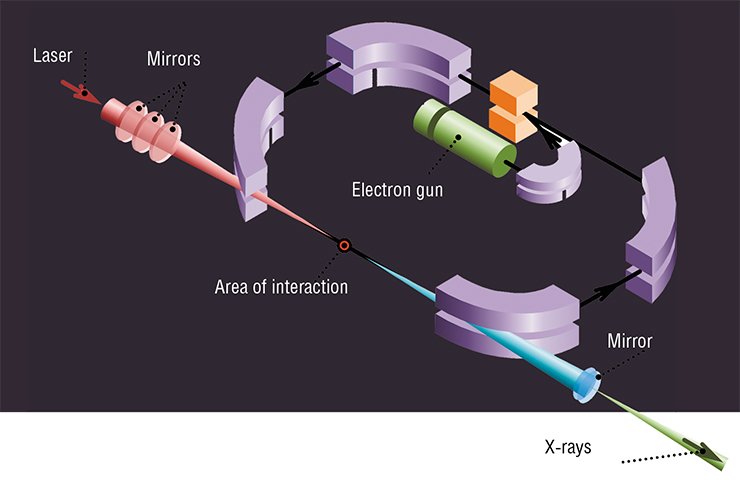
Today, you can find conventional visible-light lasers with a wavelength of about half a micron almost everywhere, from CD players to barcode scanners. However, accelerator physics and technology allow the development of X-ray lasers with wavelengths in the sub-nanometer range. Because of their small wavelengths, these lasers are indispensable for analyzing the structure of biological macromolecules, new materials, and fast processes. The source of these high-energy photons is relativistic electrons produced in accelerators. The main obstacles to the widespread use of these X-ray lasers are their size and cost (e. g., the LCLS, which was launched by SLAC (California), has a length of about one kilometer and costs about $500 million).
The conventional accelerators are known to operate on the principle of particle acceleration in resonators, i.e., metal containers of a certain shape, which create conditions for the generation of accelerating fields. However, metals have a limited ability to withstand strong electromagnetic fields due to the possible electric breakdowns and destruction of the resonator walls. However, the plasma produced in a gas stream under the influence of an intense particle beam or laser pulse provides a medium for creating a wave with amplitude not limited by breakdowns, the reason being that plasma is an “already destroyed” material. The strong electric field in the plasma “wake” track (similar to what a ship leaves on the sea surface) allows the acceleration of particles to high energies over much shorter distances than those in a conventional accelerator. The direct collision of a particle beam with laser light opens up another opportunity for the creation of X-ray light sources by using the Compton effect (visible-light photons bounce off relativistic electrons, which reduces the photons’ wavelength to a sub-nanometer scale).
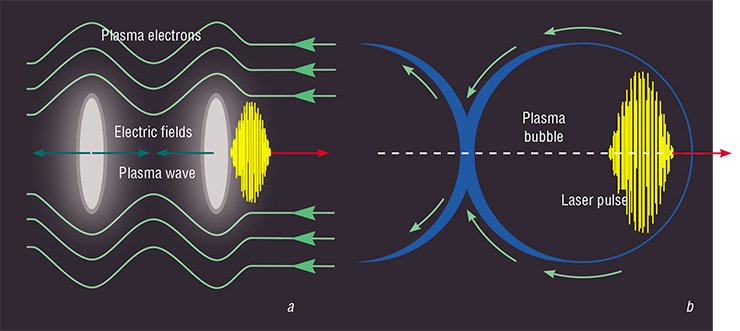
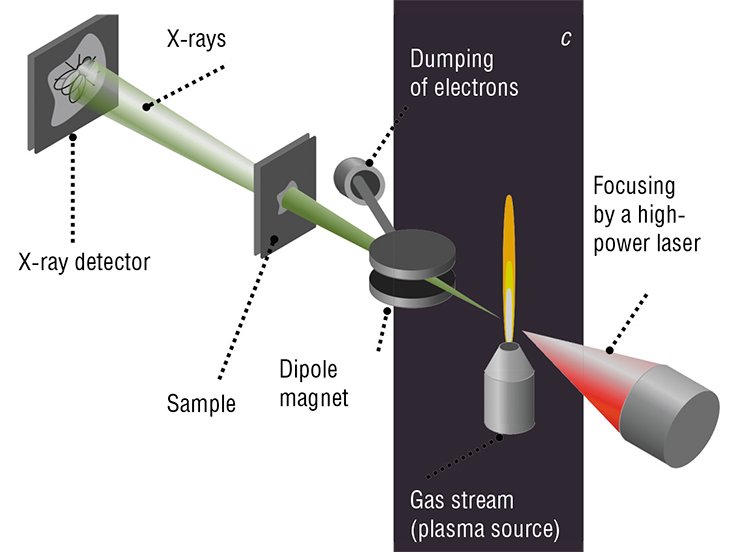
The most obvious result of the interaction of accelerator physics with laser and plasma physics is the development of new compact X-ray lasers and light sources. While there are extensive efforts underway to develop the first, simpler type of Compton X-ray sources, the more sophisticated sources will require a superconducting accelerator with energy recovery, which will provide a much stronger electron flux and, thus, higher X-ray brightness. Finally, the most complicated yet most promising task is the development of a free-electron laser based on laser-plasma acceleration. This is a highly complex problem, but the expected benefits from its solution are enormous, which inspires both the JAI and other research groups worldwide to work in this promising field.
Today various research institutions around the world are engaged in studying the interaction of laser light, plasma, and accelerated particle beams. These efforts (including the JAI’s contribution) have achieved a rate of laser-plasma acceleration that is greater than in standard accelerators by a factor of one thousand and enabled the use of accelerated beams to generate radiation in medical applications.
The first results show that plasma accelerators are very bright X-ray sources, which have such unique properties as ultrashort pulse duration (a few femtoseconds) and an extremely small size of the emitting region (a fraction of a micron). All this gives an opportunity to achieve a much higher precision of temporal and spatial resolution, compared to the existing sources.
The new family of compact plasma accelerators will allow both universities and industrial laboratories to afford their own independent research in biology, medicine, and materials science, which is currently affordable only for major technology centers.
Let there be light!
One of the important functions of the JAI is education. To convey the admiration for science and the understanding of scientific ideas and concepts, even on a simple level, to a general audience is not just one of the many tasks of the institute but part of the JAI’s mission, as stated in its official documents.

The JAI researchers are working to make accelerator physics engaging and available to a most general audience; especially for children, school teachers, and people working in other scientific fields and in the industry. Few people know that we encounter particle accelerators in our daily lives much more often than we might think. They are widely used in areas that might be quite separate from physics—from the destruction of cancerous tumors and disinfection of medical tools and food products to the detection of counterfeit works of art!
The JAI’s outreach activities include the unique and exciting show Accelerate! for school kids that explains how accelerators work using beach balls, liquid nitrogen and huge fireballs; an annual music festival that combines concerts with scientific lectures; and Appeal, an annual summer school for high school teachers of physics where they get to know what goes on at the LHC and other such accelerators and can even make a simple model of an accelerator or bubble chamber from improvised means.
The JAI’s employees deliver lectures at schools and publish popular science articles, all this being done by a relatively small staff, which largely consists of postgraduate students. I should add that the institute prepares five to eight PhD researchers per year, which is roughly as many as the Budker Institute of Nuclear Physics (Novosibirsk), a recognized world center of accelerator physics with a staff of about 3,000 employees. The “production” of highly qualified specialists with profound theoretical knowledge, practical skills, and a flexible mindset is the most important task of the JAI.
The world of accelerator physics should function as a single organism in which the basic and applied components are in an equilibrium. A physicist thinking about quarks and cosmic rays can become at the next moment an innovator ruminating over the creation of a desktop X-ray machine for hospitals or industry.
Following this principle, the JAI is determined to bring its basic research to industrial application in the near future. We hope that our research will help design compact sources of synchrotron radiation that are based on the principle of the synergy of lasers and new accelerators, and these sources will be able to revolutionize the world of accelerator physics and its applications, just as it happened with visible-light lasers, which spurred science and industry in the 20th century. In particular, the development of very compact sources of X-ray pulses, the first application of plasma accelerators, can be an inspiring piece of evidence that we are able to overcome the “Death Valley” between accelerator science and technology innovations.
“How can we transform a scientific result into something tangible and useful? I began to take a serious interest in this question only recently. Previously, when I was engaged in purely basic research, I was much less worried about such things. This question might have come with age or, perhaps, with the responsibility imposed by my present position.“To go all the way from a research idea to implementation—is a challenge. I would like to understand how to choose those projects that are worth bringing to a logical conclusion and how to achieve that.
“We try to focus our employees on practical issues and to motivate them. For example, there is an idea to create a new X-ray source with parameters that would vary in a wide range, i. e., it could work for materials science or for medicine... Which parameters should we chose and how to make the device more compact? Or, for instance, how can we make a device that will diagnose a certain type of cancer better than other diagnostic tools? When an idea has taken shape, we set out on a long journey that requires time, effort and resources. First, you need to find the single best option. If it works, then we can make different versions of the device. But you have to begin by making the first step.
“In general we have strong motivation, both from the government and universities, to first consider those things that could be put into practice and seek real-world applications and possibilities to implement them.”


